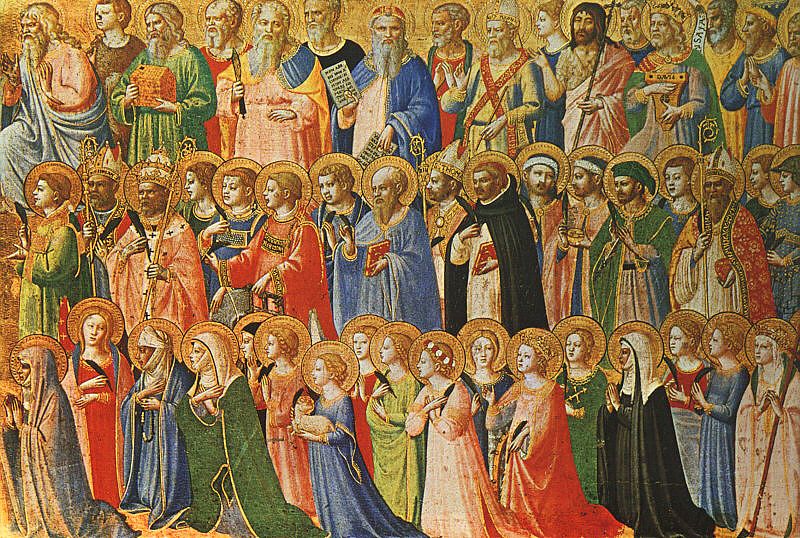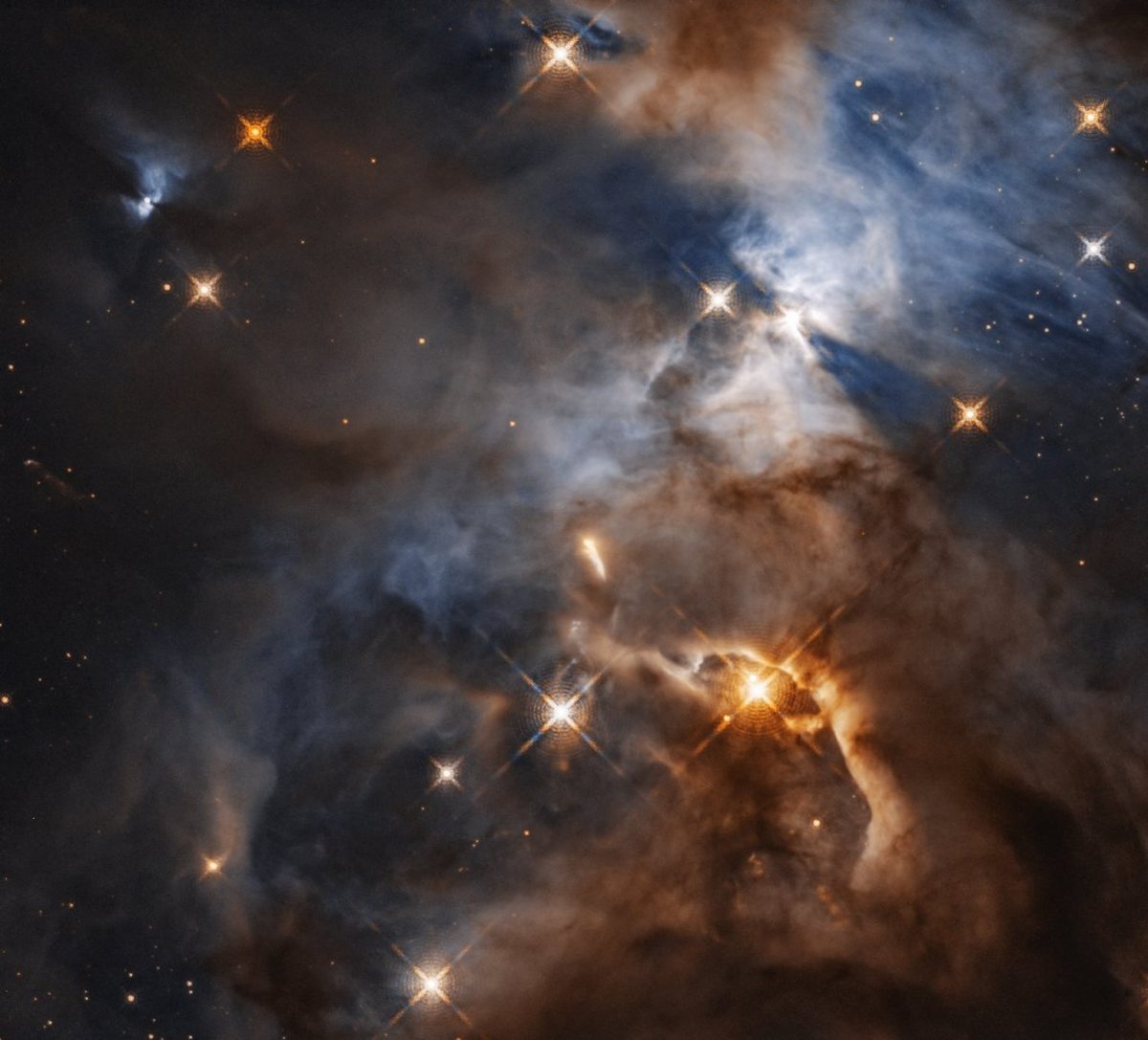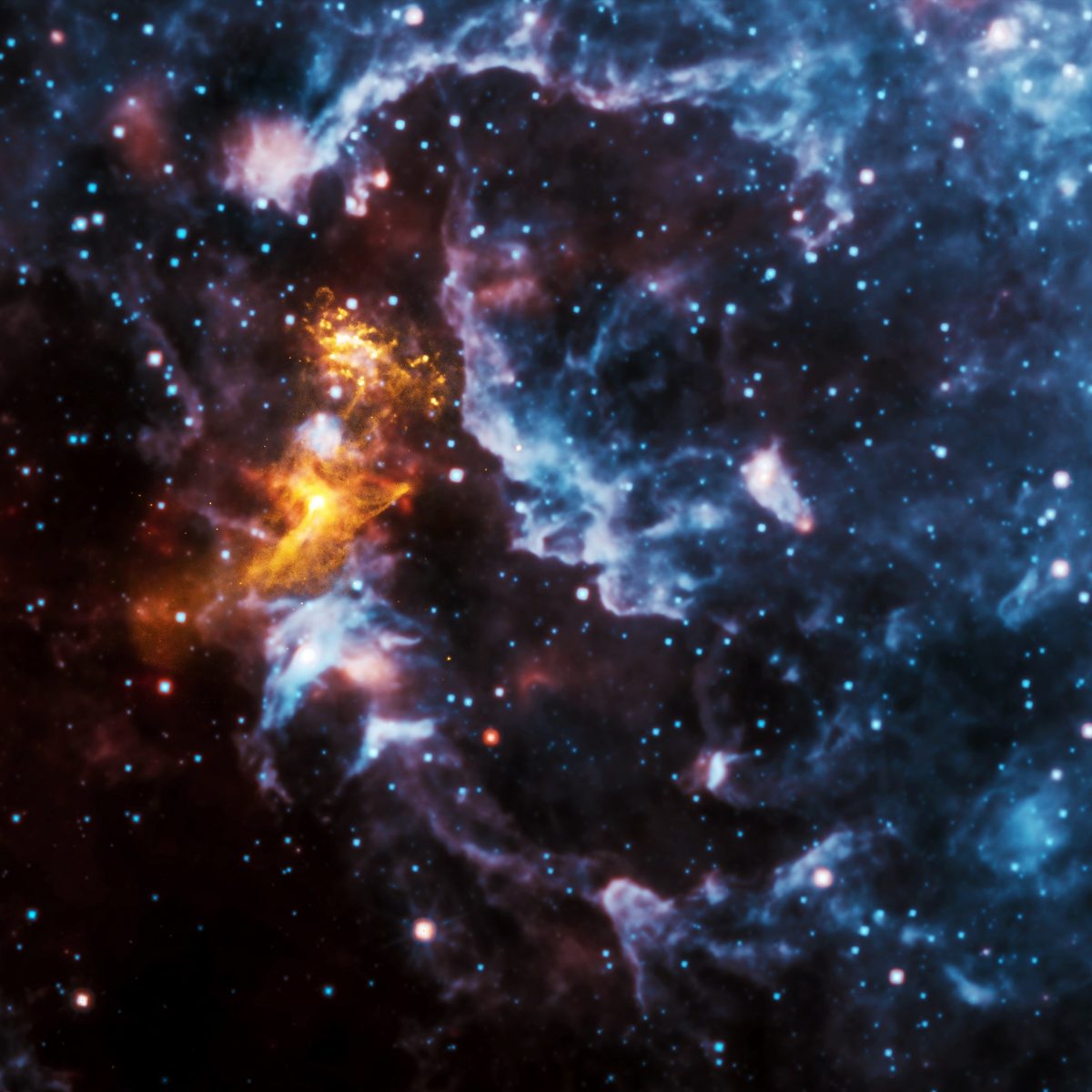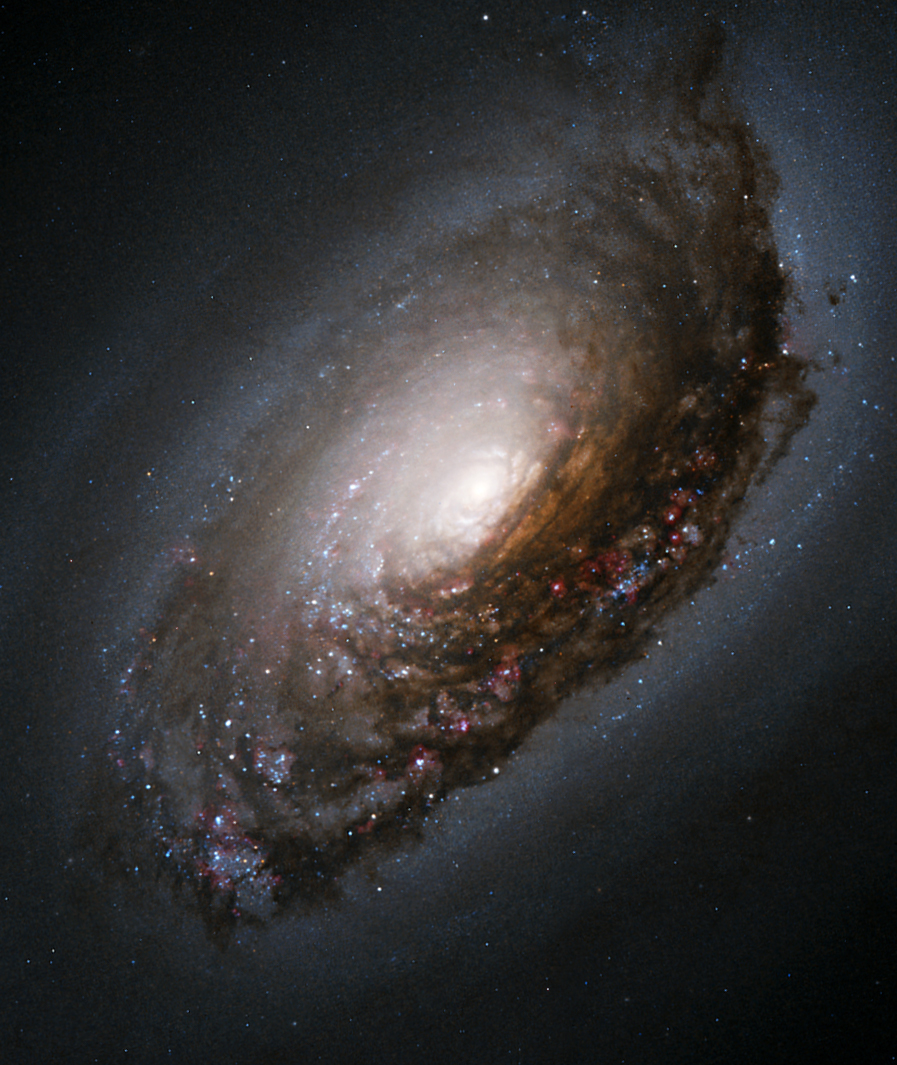Blog
Cygnus Shell Supernova Remnant W63
The ghost of a long-dead star, the W63 supernova remnant shines like a faint cosmic smoke-ring along the plane of the Milky Way galaxy toward the northern constellation Cygnus the swan. Its wraithlike appearance is traced against the region’s rich complex of interstellar clouds and dust by an eerie blue glow. Spanning over four full moons on the sky, the beautiful image is a telescopic mosaic in twelve panels that combines 100 hours of exposure time using narrow band filters. It shows characteristic light from ionized atoms of sulfur, hydrogen and oxygen in red, green, and blue hues. Likely over 5,000 light-years away, the visible part of the still expanding shell supernova remnant is around 150 light-years in diameter. So far no source has been identified as with the remains of W63’s original star. Light from the star’s supernova explosion would have reached Earth over 15,000 years ago.
more...11-2-1972
Canadian bassist and composer, Rubim de Toledo, combines the influences of his Brazilian heritage and his dedication to the jazz tradition, to create an approach to music that is refreshing and uplifting. Boasting a diverse rhythmic palette inspired by world music, jazz, and contemporary music, a lure towards improvisation and a forward-looking traditionalism, Rubim nurtures a commanding sound and style as a bassist, soloist, and composer.
Rubim began his professional career in Edmonton at the age of seventeen performing with Albertan Jazz legends, Tommy Banks, PJ Perry and Clarence “Big” Miller. Since then he has become a sought-after sideman and a productive bandleader.
With his award winning fifth release, “The Gap,” Rubim distinguishes himself as a composer with a unique ability to explore jazz styles while maintaining a sound that is modern yet inviting. Featuring internationally renowned drummer Jason Marsalis on half the record, and Albertan mainstay Jon McCaslin on the other, along with pianist Chris Andrew, the disc boasts inventive acoustic jazz trio arrangements embellished by compelling solo improvisations.
Rubim has worked extensively as musical director with Calgary’s Decidedly Jazz Danceworks. He is a passionate music educator and serves as the section head of the bass department at MacEwan University.
more...Philip Wells Woods (November 2, 1931 – September 29, 2015) was an American jazz alto saxophonist, clarinetist, bandleader, and composer.
Woods was born in Springfield, Massachusetts. He studied music with Lennie Tristano, who influenced him greatly, at the Manhattan School of Musicand at the Juilliard School. His friend, Joe Lopes, coached him on clarinet as there was no saxophone major at Juilliard at the time. Although he did not copy Charlie “Bird” Parker, he was known as the New Bird, a nickname also given to other alto saxophone players such as Sonny Stitt and Cannonball Adderley.
In the 1950s, Woods began to lead his own bands. Quincy Jones invited him to accompany Dizzy Gillespie on a world tour sponsored by the U.S. State Department. A few years later he toured Europe with Jones, and in 1962 he toured Russia with Benny Goodman
more...https://www.youtube.com/watch?v=CivHb05L7AY
more...All Saints’ Day, also known as All Hallows’ Day, Hallowmas, the Feast of All Saints, or Solemnity of All Saints,is a Christian festival celebrated in honour of all the saints, known and unknown. In Western Christianity, it is celebrated on November 1 by the Roman Catholic Church, the Anglican Communion, the Methodist Church, the Lutheran Church, the Reformed Church, and other Protestant churches. The Eastern Orthodox Church and associated Eastern Catholic Churches and Byzantine Lutheran Churches celebrate it on the first Sunday after Pentecost.[8] Oriental Orthodox churches of Chaldea and associated Eastern Catholic churches celebrate All Saints’ Day on the first Friday after Easter.
In the Western Christian practice, the liturgical celebration begins at Vespers on the evening of 31 October, All Hallows’ Eve (All Saints’ Eve), and ends at the close of 1 November. It is thus the day before All Souls’ Day, which commemorates the faithful departed. In many traditions, All Saints’ Day is part of the season of Allhallowtide, which includes the three days from 31 October to 2 November inclusive and in some denominations, such as Anglicanism, extends to Remembrance Sunday. On All Saints Day, it is common for families to attend church, as well as visit cemeteries in order to lay flowers and candles on the graves of their deceased loved ones. It is a national holiday in many historically Christian countries.
more...Shadows on Earth can be mysterious and foreboding, but when they occur in space, they can convey information we otherwise could not know. In a stellar nursery called the Serpens Nebula, nearly 1,300 light-years away, a young star’s game of shadow play is revealing secrets of its unseen planet-forming disk. The near-infrared vision of NASA’s Hubble Space Telescope captured the shadow cast by the fledgling star’s brilliant light being blocked by this disk.
Named HBC 672, this Sun-like star is surrounded by a debris ring of dust, rock, and ice—a disk that is too small and too distant to be seen, even by Hubble. But like a little fly that wanders into the beam of a flashlight shining on a wall, its shadow is projected large upon the cloud in which it was born.
In this Hubble image, the feature—nicknamed the “Bat Shadow”—spans approximately 200 times the length of our solar system. It is visible in the upper right portion of the picture. …
The presence of a shadow means that the disk is being viewed nearly edge-on. This is something that could not otherwise be known because of the disk’s great distance from us, which makes it too small to be seen by Hubble.
The disk’s shadow is similar to what is produced by a cylindrical lamp shade. Light escapes from the top and bottom of the shade, but along its circumference, dark cones of shadow form. Although the disk that gives rise to the shadow is a common object around young stars, the combination of an edge-on viewing angle and the surrounding nebula is rare. …
Lyle Pearce Lovett (born November 1, 1957) is an American country singer-songwriter and actor. Active since 1980, he has recorded 13 albums and released 25 singles to date, including his highest entry, the number 10 chart hit on the U.S. Billboard Hot Country Songs chart, “Cowboy Man”. Lovett has won four Grammy Awards, including Best Male Country Vocal Performance and Best Country Album. It’s Not Big It’s Large was released in 2007, where it debuted and peaked at number 2 on the Top Country Albums chart. A new studio album, Natural Forces, was released on October 20, 2009 by Lost Highway Records. The last studio album on his Curb Records contract, Release Me, was released in February 2012.
Lovett was born in Houston, Texas
more...Lou Donaldson (born November 1, 1926) is a jazz alto saxophonist. He is best known for his soulful, bluesy approach to playing the alto saxophone, although in his formative years he was, as many were of the bebop era, heavily influenced by Charlie Parker.
Donaldson was born in Badin, North Carolina. He attended North Carolina Agricultural and Technical State University in Greensboro in the early 1940s. He enlisted in the U.S. Navy during World War II and was trained at the Great Lakes bases in Chicago, where he was introduced to bop music in the lively club scene.
Donaldson is best known now for his soulful, funky 1960s recordings that feature some of the greatest soul jazz players ever to record. These include guitarists Grant Green, Melvin Sparks, Jimmy Ponder and George Benson, organists John Patton, Billy Gardner, Lonnie Smith, Charles Earland and Leon Spencer, Jr, drummers Ben Dixon (one of the great underrated groovers), and Leo Morris/Idris Muhammad, whose work on the kit defined the funky boogaloo soul jazz sound of the late 1960s. Records such as Good Gracious! (1963, Blue Note), Musty Rusty (1965, Cadet), Alligator Bogaloo [sic], Mr. Shing-A-Ling (1967, Blue Note) and Hot Dog (1970, Blue Note), among others, are quintessential examples of the jukebox, funky, soulful 1960s jazz that came to define “rare grooves” in the soul jazz revival period of the 1990s.
https://www.youtube.com/watch?v=Y4_CAag8rII
more...Portugal
more...PSR B1509-58 is a pulsar approximately 17,000 light-years away in the constellation of Circinus discovered by the Einstein X-Ray Observatory in 1982. It appears approximately 1,700 years old, and it sits in a nebula that spans about 150 light years. NASA described the star as “a rapidly spinning neutron star which is spewing energy out into the space around it to create complex and intriguing structures, including one that resembles a large cosmic hand.” Which is also known by name “Hand of God”. Spin rate is “almost 7 times per second”.
more...
Booker Telleferro Ervin II (October 31, 1930 – August 31, 1970) was an American tenor saxophone player. His tenor playing was characterised by a strong, tough sound and blues/gospel phrasing. He is best known for his association with bassist Charles Mingus.
Ervin was born in Denison, Texas. He first learned to play trombone at a young age from his father, who played the instrument with Buddy Tate. After leaving school, Ervin joined the United States Air Force, stationed in Okinawa, during which time he taught himself tenor saxophone. After completing his service in 1953, he studied at Berklee College of Music in Boston. Moving to Tulsa in 1954, he played with the band of Ernie Fields.
Ervin moved to New York City to join Horace Parlan‘s quartet, with whom he recorded Up & Down and Happy Frame of Mind (both for Blue Note Records). Ervin worked with Charles Mingus from 1956 to 1963. During the 1960s, Ervin led his own quartet, recording for Prestige Records with, among others, ex-Mingus associate pianist Jaki Byard, along with bassist Richard Davis and Alan Dawson on drums.
Ervin later recorded for Blue Note Records and played with pianist Randy Weston, with whom he recorded between 1963 and 1966. Weston has said: “Booker Ervin, for me, was on the same level as John Coltrane. He was a completely original saxophonist…. He was a master…. ‘African Cookbook’, which I composed back in the early ’60s, was partly named after Booker because we (musicians) used to call him ‘Book,’ and we would say, ‘Cook, Book.’ Sometimes when he was playing we’d shout, ‘Cook, Book, cook.’ And the melody of ‘African Cookbook’ was based upon Booker Ervin’s sound, a sound like the north of Africa. He would kind of take those notes and make them weave hypnotically. So, actually the African Cookbook was influenced by Booker Ervin.”
Ervin died of kidney disease in New York City in 1970, aged 39.
https://www.youtube.com/watch?v=UEhcsJvUwsA
more...Jean-Baptiste “Illinois” Jacquet (October 30, 1922 – July 22, 2004) was an American jazz tenor saxophonist, best remembered for his solo on “Flying Home“, critically recognized as the first R&B saxophone solo.
Although he was a pioneer of the honking tenor saxophone that became a regular feature of jazz playing and a hallmark of early rock and roll, Jacquet was a skilled and melodic improviser, both on up-tempo tunes and ballads. He doubled on the bassoon, one of only a few jazz musicians to use the instrument.
Jacquet was born to a Black Creole mother and father, named Marguerite Trahan and Gilbert Jacquet, in Louisiana and moved to Houston, Texas, as an infant, and was raised there as one of six siblings. His father was a part-time bandleader. As a child he performed in his father’s band, primarily on the alto saxophone. His older brother Russell Jacquet played trumpet and his brother Linton played drums.
https://www.youtube.com/watch?v=sQjDAFCXLS8
more...Ethel Waters (October 31, 1896 – September 1, 1977) was an American singer and actress. Waters frequently performed jazz, big band, and pop music, on the Broadway stage and in concerts, but she began her career in the 1920s singing blues. Waters notable recordings include “Dinah“, “Stormy Weather“, “Taking a Chance on Love“, “Heat Wave“, “Supper Time“, “Am I Blue?“, “Cabin in the Sky“, “I’m Coming Virginia“, and her version of the spiritual “His Eye Is on the Sparrow“. Waters was the second African American, after Hattie McDaniel, to be nominated for an Academy Award. She was the first African-American to star on her own television show, in 1939, and the first African-American woman to be nominated for an Emmy Award, in 1962.
https://www.youtube.com/watch?v=FN8-Yy8Rl3s
more...https://www.youtube.com/watch?v=qkkvfXNnQIU
more...New Zealand
more...The Black Eye Galaxy (also called Evil Eye Galaxy; designated Messier 64, M64, or NGC 4826) is a galaxy which was discovered by Edward Pigottin March 1779, and independently by Johann Elert Bode in April of the same year, as well as by Charles Messier in 1780. It has a spectacular dark band of absorbing dust in front of the galaxy’s bright nucleus, giving rise to its nicknames of the “Black Eye” or “Evil Eye” galaxy. M64 is well known among amateur astronomers because of its appearance in small telescopes. It is a spiral galaxy in the Coma Berenices constellation.
The interstellar medium of Messier 64 consists of two counter-rotating disks that are approximately equal in mass. The inner disk contains the prominent dust lanes of the galaxy. The stellar population of the galaxy exhibits no measurable counter-rotation. Possible formation scenarios include a merger with a gas-rich satellite galaxy in a retrograde orbit, or the continued accretion of gas clouds from the intergalactic medium. It has a diameter of 52,962 light-years (16.238 kpc)
more...
More Posts
- Carole King
- Ernest Tubb
- Walter Page
- Carmen Miranda
- Flamenco Fridays Camarón con Ramón de Algeciras
- Daily Roots Kailash
- Cabaret @ Mixed Blood
- Cosmos NGC 104
- Floyd Dixon
- John Williams
- Lonnie Johnson
- World Music Sungu Lubuka
- Daily Roots Bob Marley
- Bob Marley Interview by Martin Keller 1978?
- Cosmos NGC 4038
- Earl King
- King Curtis
- Eubie Blake
- Daily Roots Yabby You
- MARDI GRAS DAY 2024-One Week From Today






